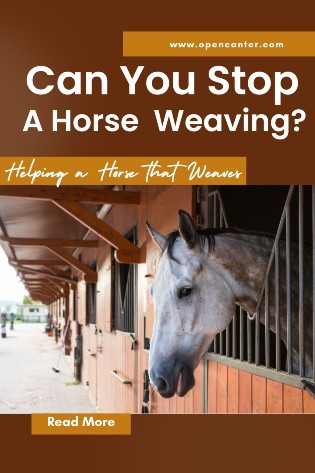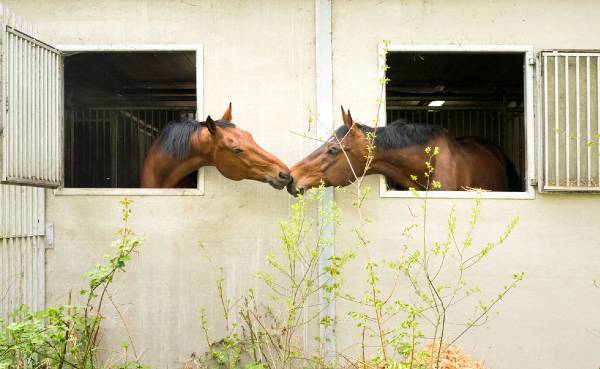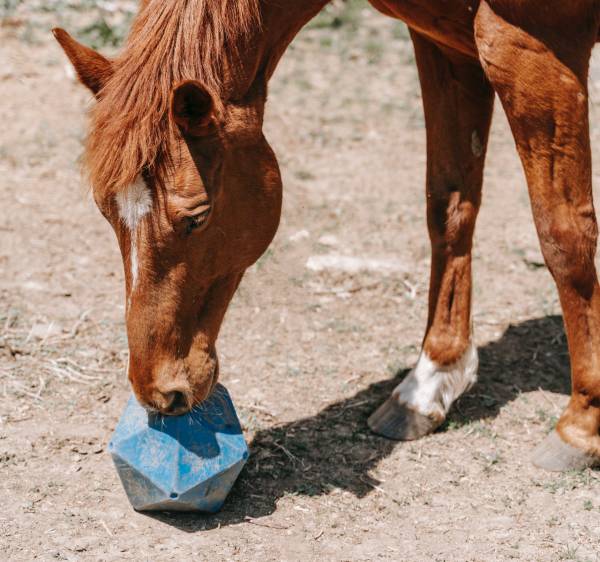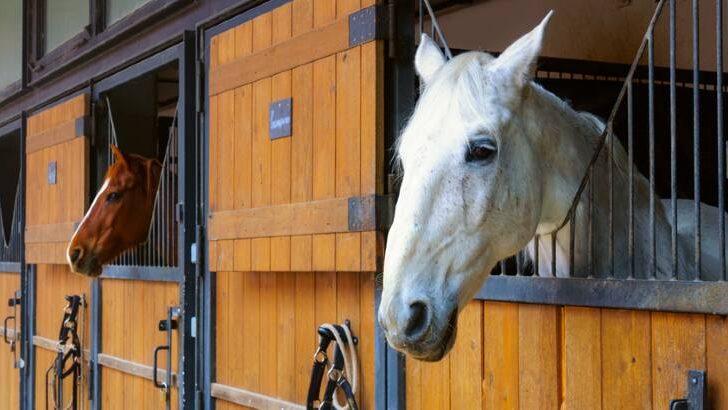Affiliate Disclaimer
As an Amazon Associate I earn from qualifying purchases. It helps me keep the website going. Thank you for your support.
Weaving is a repetitive swaying motion exhibited by some horses in stables or along fence lines. Similar to nail biting in humans, it is a coping mechanism for horses. Weaving has been shown to cause a release of endorphins, or ‘feel-good’ hormones. This means it can very easily and quickly become an addictive habit! This is what makes it very challenging to stop a horse from weaving.
Prevention or early intervention is best – act as soon as you notice your horse is upset or starting to weave. The longer a horse has been weaving, the harder it will be to change their behavior. Once it has become a habit, it can be very difficult or impossible to stop a horse weaving. However, there are steps you can take to reduce the behavior to a rarity.
Weaving is a behavior that horses don’t choose. Instead, it starts as a way to help them cope with their environment. By working to stop a horse weaving, you will be improving their mental and physical wellbeing. Read on to learn more about strategies that can be used to help the weaving horse.

Can You Stop a Horse From Weaving?
Like other stereotypic behaviors, weaving is not ‘curable’. There are no quick fixes that directly address the weaving; but rather steps that help to manage it. If this is done correctly, the amount of time even chronic weavers spend weaving can be greatly reduced.
However, if these management strategies were to lapse, the weaving behavior will likely return. For example, the horse who weaves when stabled might very rarely weave in the field. However, put them back into a stable and the weaving will start again.
This is because weaving is a coping mechanism. Horses don’t weave if they are happy in their environment and are not stressed. To stop a horse weaving, you need to make changes to improve their environment.
It can be a challenging process to stop or reduce weaving behavior. Careful management of the horse’s environment and routine is required. Weaving can become addictive, which makes it even harder to manage.
Horses who have stopped weaving can very quickly start again, in times of stress or boredom. For these horses, the focus is on managing the weaving rather than stopping it entirely.
Figuring Out Why Your Horse is Weaving?
The first step to stopping a horse from weaving is to work out why they are weaving. Weaving is a behavior horses develop in response to certain environmental conditions. It is not something that they learn from watching other horses.
Factors such as social isolation, stress, boredom, or confinement can contribute to weaving behavior. Horses who are stabled or kept in small yards are at a higher risk of developing weaving behavior. Similarly, horses who cannot touch other horses or whose herd mates constantly come and go are also at higher risk.
To work out why your horse is weaving, you need to analyze your management practices. Is your horse stabled all day, only overnight, or rarely? While your horse is stabled, can they touch any other horses? Or see any goings on?
Horses who are stabled need some form of stimulation to help keep boredom at bay. They should always be able to at least see other horses, preferably be able to touch them. They also need adequate exercise, either in the form of turnout or being ridden.

Does your horse have feed to constantly graze on in the form of grass or hay? Or do they only receive feeds at certain times? Horses are designed to graze, and periods of time spent without food can cause anxiety. Additionally, it has numerous negative health impacts on the horse’s digestive system.
Does your horse have a consistent herd around them, or are things constantly changing? Horses coming and going can cause stress due to social isolation. Does your horse’s daily routine change frequently?
All of these factors affect how your horse is feeling. Some horses are more sensitive than others, and the smallest changes can cause huge effects. Horses start to weave as a way to cope with their overwhelming feelings of stress, anxiety, or boredom.
How Do You Stop a Horse From Weaving?
Once you have worked out why your horse is weaving, you need to decide on what changes to make. These changes will all address parts of the horse’s living environment and routine, depending on the cause.
For the stabled weaver, the first strategy is to increase turnout time and reduce stable time. It’s recommended that stabling be completely removed from the horse’s routine. However, in some cases, this is not possible.
Increasing turnout will give your horse more exercise. They will be able to move around throughout the day, not only when you exercise them. They will also spend much of their time grazing, and less of their time weaving. That being said, some horses do weave when they are in the field. You can read more about horses that weave when they are turned out here.
Make sure your horse gets enough exercise. Horses who have too much energy will likely suffer from higher levels of boredom or anxiety. If riding is not an option, then consider other things like lunging, groundwork, or teaching your horse tricks.

For horses who weave due to social isolation, providing a paddock or stable buddy is a popular solution. This could be another horse or another animal like a goat or a sheep. For these horses, it is important that you give them a constant friend. You can read more about good companion animals for horses here.
Smaller companion animals work well, as they can be stabled with your horse. Another option is to install a mirror or posters in your horse’s stall. These can help reduce feelings of social isolation. However, this may not be overly effective, as your horse will still be lacking social contact.
What To Do When Increased Turnout Is Not An Option
If you still need to stable your horse, it is unlikely that you can completely stop them from weaving. However, there are strategies you can use to reduce the amount of time they spend weaving.
For starters, make sure your horse has enough opportunity for exercise. This means that you might need to take them on walks during the day, as well as riding. Additionally, make sure their stable has plenty of room for them to move around.
Make sure that your horse can see other horses while in the stable. Stables with walls that are half solid and half bars or mesh are a great design option. This allows horses to see and interact with each other, but not hurt each other through the bars or mesh.
Another option is to consider installing an anti-weaving door. This is a V-shaped frame that sits atop most normal stall doors. When the horse hangs their head over the door, they are unable to weave due to its shape.
Anti-weaving stall doors only work for horses who weave over the stall door. It is best used alongside other management changes. Your horse might simply continue weaving, but now do it whilst standing inside their stall.
Does Simple Distraction Work?
Distraction can be a useful strategy when your horse is required to be subject to long periods of inactivity. For example, if you have to stable your horse, then giving them some distractions in their stable can help reduce or stop weaving.
Using toys in your horse’s stable is a good option. There are many available to buy, like treat balls, shakers, or rubber balls. Make sure the toy you choose is safe for your horse. It can’t have any sharp edges and must be solid enough to withstand rough play.
Also, make sure the toy is large enough that your horse won’t be tempted to eat it. Some rubber dog toys work well, but make sure they are large enough. It will be trial and error to find a toy that your horse likes enough to distract them from weaving.

Using food also works as a distraction. However, you don’t want to start feeding your horse excessively just to give them something to do. There are options like slow feeder hay nets or feed buckets available.
These are designed to make the horse take much longer to eat their feed. Slow-feeder hay nets have small holes, so the horse can only pull out small amounts of hay in each bite. Slow feeder buckets are specially shaped so that your horse can’t just take giant mouthfuls.
Is There Medication to Help Stop a Horse From Weaving?
Severe or chronic weavers may benefit from supplements or medication. This is usually when other options have been exhausted and the horse is still weaving with little or no change. It is best to consult with your vet to have your horse checked over and to recommend a suitable product.
There are many equine calming supplements that can help ‘take the edge off’ (source). These can be useful for horses who are weaving due to stress or anxiety. Adding a calming supplement long term can mean other strategies are more effective at reducing weaving.
There are some veterinary-prescribed medications available to calm horses. These will only be available through your vet, and they may be required to administer them. These products are usually for shorter-term use, to help break the addiction to weaving.
Final Thoughts
It is a challenging process to stop a horse weaving – and often, it is impossible to completely stop the behavior. Stopping a horse from weaving involves careful management and routine changes, to address the cause of the weaving. Approaching the issue with a focus on your horse’s overall health and happiness will give you the best of success.




